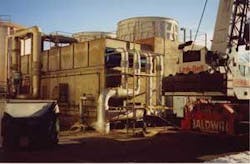Niagara Blower heat transfer solution aids wastewater cooling at Texas refinery
Prescription drugs found in drinking water raise ruckus
An Associated Press report on a vast array of pharmaceuticals, including antibiotics, mood stabilizers, sex hormones and other endocrine disrupters, found in drinking water supplies of 24 metropolitan areas serving at least 41 million Americans sparked nationwide concern. The American Water Works Association noted: “To date, however, research throughout the world has not demonstrated an impact on human health from pharmaceuticals in drinking water at the trace levels at which they have been found.” Still, a number of community public water supply providers underscored technology to treat drinking water sources and announced plans to monitor the problem more closely. The U.S. Fish & Wildlife Service and American Pharmacists Association (APhA) also signed an agreement to help protect fish and aquatic resources from improper disposal of medication via an effort dubbed “SMARxT Disposal.” In the report’s wake, companies touting their ability to monitor or treat pharmaceuticals in drinking water included Waters Corp., Kinetico, Applied Biosystems and Teleosis Institute. The Water Quality Association stressed point-of-use/point-of-entry technologies to further reduce such compounds in drinking water.
House bill reconsiders permanent chemical security rules
On March 11, the House Committee on Homeland Security introduced the Chemical Anti-Terrorism Act of 2008. The American Chemistry Council (ACC), which supports the legislation, said its members set the standard by voluntarily investing more than $5 billion to enhance security through ACC’s Responsible Care® Security Code. Meanwhile, the Synthetic Organic Chemical Manufacturers Association (SOCMA) and National Association of Chemical Distributors (NACD) urged a more cautious approach. SOCMA president Joseph Acker derided the committee’s passage of legislation mandating inherently safer technologies (IST) as a tool against terrorism. “SOCMA supports making chemical site security standards a permanent and enforceable law under the jurisdiction of the U.S. Department of Homeland Security. We are, however, stridently opposed to the merits of mandating inherently safer technology (IST) under the guise of site security and as a panacea for fighting terrorism,” he said.
Siemens wins ultrapure, pulp & paper contracts
Georgia Tech picked Siemens Water Technologies to provide water treatment systems for a new, $80 million nanotechnology research center in Atlanta that will be critical to research and instruction in microelectronics, semiconductors, materials, medicine and pharmaceuticals. A wastewater system will treat acid/or alkaline waste streams, and the ultrapure system is designed to meet very tight water quality specifications required by the center’s research programs. Slated for completion in October 2008, the new center will be the most advanced nanotechnology facility in the Southeast, the first of its kind in the region and one of the most sophisticated in the country. In other news, Siemens won an order to install an MBR plant with downstream RO for wastewater treatment from Albert Köhler GmbH & Co. KG in Gengenbach, Germany, which produces about 40,000 tonnes of paperboard a year for folders, books and packaging.
World Water Works wins contract with P&G
Procter & Gamble has awarded Oklahoma City’s World Water Works Inc. a contract to supply two www/Resource RSP-13L Dissolved Air Flotation (DAF) Systems rated at 4,700 gpm each. Constructed of polypropylene using WWW’s proprietary welding technology, the systems also feature the Nikuni dissolved air technology. P&G and others have used the Nikuni technology to upgrade existing DAFs to improve performance and reduce energy consumption. These systems will be delivered in July 2008.
USDA, DOE to invest in biomass R&D
The U.S. Department of Agriculture and U.S. Department of Energy will invest up to $18.4 million, over three years, for 21 biomass research and development (R&D), and demonstration projects. These projects specifically aim to address critical barriers to making production of biomass more efficient and cost-effective, in an effort to advance the Bush Administration’s strategy of bringing online more clean, bio-based products and biofuels to help reduce our dependence on oil from unstable parts of the world and mitigate climate change.
Veolia technology desalinates oilfield produced water
N.A. Water Systems, a Veolia Water Solutions & Technologies company, touted its successful full-scale demonstration of OPUS™ technology for produced water treatment at Chevron U.S.A. Inc.’s oilfield in San Ardo, CA. The first produced water desalination facility in the world that uses this technology, it enables Chevron to expand steam-enhanced production into an idled, previously developed portion of the field. The technology, which is sized to treat 50,000 barrels of water per day in San Ardo, was developed through joint efforts of Chevron and N.A. Water Systems. Its processes include degasification, chemical softening, media filtration, ion exchange softening, cartridge filtration and reverse osmosis. The overall project also included expansion of water softening facilities. The softened water is used in Chevron’s once-through steam generators, which produce the steam for oil extraction.
Nalco donations to Water For People top $250,000
Nalco cited two of its most recent innovations in reducing industrial freshwater withdrawals globally in announcing for World Water Day a $50,000 donation from the Nalco Foundation to Water For People, to which it’s given $250,000 since 2004. In 2007, its 3D TRASAR® cooling water chemistries monitoring technology saved about 40 billion gallons of water in Europe and North America. And paper industry customers using its PARETO™ Wet-End Optimization water reuse technology have seen savings of over 600 million gallons of freshwater a year.
AWWARF issues RFPS for $4 million in grants
The Awwa Research Foundation (AwwaRF) has issued requests for proposals (RFPs) for 15 solicited projects on its 2008 research agenda. AwwaRF is providing over $4 million in funding to sponsor the projects. The RFPs, available at www.awwarf.org, collectively represent a wide range of topics of critical importance to the drinking water community, including: Lead and Copper Corrosion Control in New Construction, Qualitative Structure Property Relationships (QSPR) to Predict Removal of EDC/PPCPs in Water Treatment Processes, Interpreting Real-Time Online Monitoring Data for Water Quality Event Detection, Water Industry Contribution to Epidemiological and Health Effects Studies Involving Distribution System Water Quality and Implementing Effective Asset Management In Water Utilities.
GLOBE Foundation announces award winners
Among six recently announced winners of the 2008 GLOBE Awards for Environmental Excellence presented in March by the GLOBE Foundation of Canada were EnCana Corp. and BioteQ Environmental Technologies. EnCana, a natural gas and integrated oil sands company that produces 4.4 billion cubic feet of gas equivalent a day, won the Corporate Environmental Excellence Award. In the category of Export Performance, BioteQ was picked for work with the world’s leading mining companies and utility operators to reduce environmental liabilities while generating revenue from waste. BioteQ builds, owns and operates water treatment plants that produce saleable metal products that can pay for water treatment costs, and clean water that can be discharged to the environment.
National lab wins sewer monitoring award
The California Water Environment Association’s Pretreatment, Pollution Prevention and Stormwater (P3S) committee presented its “Facility of the Year” award to Lawrence Livermore National Laboratory’s (LLNL) Sewer Monitoring Team in the LLNL Environmental Protection Department. The team operates the lab’s sewer monitoring complex, which handles sewage effluent from both LLNL and Sandia National Laboratories-Livermore. The team was nominated for the award by the city of Livermore’s Water Resources Division.
WATER HEADLINES
Among other recent headlines at www.industrialww.com, see:
- MWH, AwwaRF, CEC to develop global desalination research forum
- Regenesis, URS win DOD grant to develop GIS as bioremediation tool
- Battelle, Ferratec bring production of ferrate(VI) closer to reality
- First of two cooling towers valued at $96 million up at Georgia Power’s Smyrna plant
- New Western Progress report calls for sustainable policies to address water issues
- Biogas from Ecovation wastewater system to help power Pratt recycled paper plant
- Weston wins construction management in $80 million Long Beach remediation effort
- RG Global’s Catalyx Fluid Solutions first CBM water plant nearly done in Wyoming
- Alstom polyethylene pipes replace concrete in power station’s cooling water intake
- $250 million in equity pledged to develop Water Standard Co.’s desalination vessels
- Eco-Tec launches innovative biogas technology for global market
- PBS&J acquires EcoScience
- Ecolab buy of Ecovation expands its biogas, effluent management services
- Dow announces global price increase for biocides, DOWEX resins
- Peerless Pump acquires Flometrico
- MIOX system installed on naval warship USS New York
- Aquatech International, Hach win export awards
- CH2M Hill’s McKelvy, Gearhart to lead Life Sciences, Industrial groups
- Douglas Barwick Inc. obtains NSF certification for stainless steel pipe, fittings
- Planet Resource Recovery successfully removes barium in oil-contaminated water
- AECOM to acquire Boyle Engineering, Tyco’s Earth Tech
- Ex-Im Bank backs Bio-Microbics’ sale of 10 wastewater systems to Mexico’s Acuapro
- Veolia’s John Meunier Inc. to introduce AnoxKaldnes MBBR technology in Canada
- Adventus Group receives remediation technology award
- Pilgrim’s Pride earns ecomagination award, GE Water invests in China factory
- Emerson delivers 750,000th Fisher smart digital valve controller
- Niagara Blower acquires Kathabar Inc.


